Communist symbolism
Communist symbolism represents a variety of themes, including revolution, the proletariat, peasantry, agriculture, or international solidarity.
Communist states, parties and movements use these symbols to advance and create solidarity within their cause. These symbols often appear in yellow and red. The flag of the Soviet Union incorporated a yellow-outlined red star and a yellow hammer and sickle on red. The flags of Transnistria, Vietnam, China, North Korea, Angola and Mozambique would all incorporate similar symbolism under communist rule.
The hammer and sickle have become the pan-communist symbol, appearing on the flags of most communist parties around the world. Some parties have a modified version of hammer and sickle as their symbol, most notably the Workers' Party of Korea which includes a hammer representing industrial workers, a hoe representing agricultural workers and a brush (traditional writing-implement) representing the intelligentsia.
In Hungary,[1] Latvia, Indonesia, Poland, Ukraine and Lithuania, communist symbols are banned and displays in public for non-educational use are considered a criminal offense.[2]
Hammer and sickle
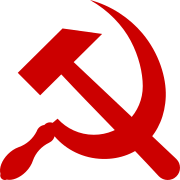
The hammer stands for the industrial working class and the sickle represents the agricultural workers, therefore together they represent the unity of the two groups.
The hammer and sickle were first used during the 1917 Russian Revolution, but it did not become the official symbol of the Russian Soviet Federative Socialist Republic until 1924. Since the Russian Revolution, the hammer and sickle have come to represent various communist parties and communist states.
Red star
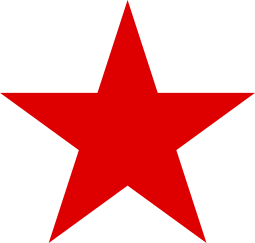
The five-pointed red star is a symbol of communism as well as broader socialism in general. The red star was a revolutionary symbol after the October Revolution and following civil war in Russia. It was widely used by anti-fascist resistance parties and underground organizations in Europe leading up to and during World War II. During the war, the red star was prominently used as a symbol of the Workers' and Peasants' Red Army from the Soviet Union, which liberated its country from the invading forces of Nazi Germany and went on to rid the rest of Eastern Europe from the fascist occupation forces, achieving absolute victory and ending the war at the Battle of Berlin. Most states in the Eastern Bloc incorporated the red star into state symbols to signify their socialist nature.
While there is no known original allegory behind the red star beyond being a universal political symbol, in the Soviet Union the red star gained a more precise symbolism as representing the Communist Party and its position on the flag over the united hammer and sickle symbolised the party leading the Soviet working class in the building of communism. Today, the red star is used by many socialist and communist parties and organizations across the world.
Red flag
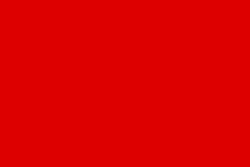
The red flag is often seen in combination with other communist symbols and party names. The flag is used at various communist and socialist rallies like May Day. The flag, being a symbol of socialism itself, is also commonly associated with non-communist variants of socialism.
The red flag has had multiple meanings in history, but it was first used as a flag of defiance.[3] The red flag gained its modern association with communism in the 1871 French Revolution. After the October Revolution, the Soviet government adopted the red flag with a superimposed hammer and sickle as its national flag. Since the October Revolution, various socialist states and movements have used the red flag.
Red and black flag
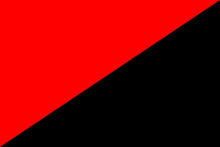
The red and black flag has been a symbol of general communist movements, though generally used by anarcho-communists. The flag was used as the symbol of the anarcho-syndicalists during the Spanish Civil War. The black represents anarchism and the red represents leftist and socialist ideals.[4] Over time, the flag spilled into statist leftist movements, these movements include the Sandinistas and the 26th of July Movement, where the flags colors are not divided diagonally, but horizontally. As in the case of the Sandinistas, they adopted the flag due to the movement's anarchist roots.[5]
The Internationale
The Internationale is an anthem of the Communist movement.[6] It is one of the most universally recognized songs in the world and has been translated into nearly every spoken language. Its original French refrain is C'est la lutte finale/Groupons-nous et demain/L'Internationale/Sera le genre humain (English: This is the final struggle/Let's group together and tomorrow/The International/Will be the human race). It is often sung with a raised fist salute.
The song has been used by communists all over the world since it was composed in the 19th century and adopted as the official anthem of the Second International. It later became the anthem of Soviet Russia in 1918 and of the Soviet Union in 1922. It was superseded as the Soviet Union anthem in 1944 with the adoption of the State Anthem of the Soviet Union, which placed more emphasis on patriotism. The song was also sung in defiance to Communist governments, such as in the German Democratic Republic in 1989 prior to reunification as well as in the People's Republic of China during the Tienanmen Square protests of the same year.
Plough (or Starry Plough)
.svg.png)
Although not an exclusively communist symbol, the Plough, or Starry Plough, is a symbol of Irish socialism. It may have the same roots as the original hammer and Plough that was replaced by the hammer and sickle in Soviet Russia. The significance of the banner was that a free Workers Republic of Ireland would control its own destiny from the plough to the stars and the sword forged into the plough would mean the redundancy of war with the establishment of a socialist International. The flag depicts the Big Dipper, part of the constellation of Ursa Major that is known as "The Plough" in Ireland and Great Britain. The Plough is one of the most prominent features of the night sky over Ireland throughout the year. This was unveiled in 1914 and flown by the socialist workers' militia (the Irish Citizen Army) during the 1916 Easter Rising.
.png)
In China, the Plough flag (Chinese: 犁头旗), a red flag with white or yellow plough, is widely used in the period of the First Revolutionary Civil War as the flag of the Chinese peasant associations, an organization led by the Communist Party of China.[7][8] It is believed that Peng Pai (Chinese: 彭湃) was the first user in 1923 at the peasants' association of Hailufeng.[9] The Plough flag has many different versions and some are combined with the flag of Blue Sky, White Sun or Red Field;[10] other are different on the details of the plough.[11][12]
Socialist heraldry
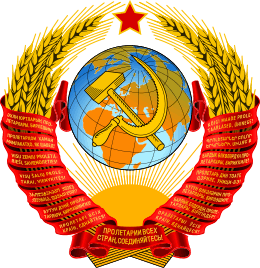
Many communist governments purposely diverged from the traditional forms of European heraldry in order to distance themselves from the monarchies that they usually replaced, with actual coats of arms being seen as symbols of the monarchs. Instead, they followed the pattern of the national emblems adopted in the late 1910s and early 1920s in Soviet Russia and the Soviet Union.
Socialist heraldry, also called communist heraldry, is a colloquial name for the common design patterns of the national emblems adopted by communist states. Although commonly called coats of arms, most such devices are not actually coats of arms in the traditional heraldic sense, but the recognisable common patterns have led to the use of the unofficial term "socialist heraldry".
Other communist symbols
While not necessarily communist in nature, the following graphic elements are often incorporated into the flags, seals and propaganda of communist countries and movements.
- Revolutionary music as well as protest music. The Internationale falls under this category.
- Socialist realism, an art style developed in the Soviet Union.
- Crossed proletarian implements, including picks, hoes, scythes and in the case of the Workers' Party of Korea a brush to represent the intelligentsia. The ubiquitous hammer and sickle also belong in this category.
- Rising sun, exemplified on the state emblems of the Soviet Union, Turkmenistan, Croatia, Romania and PASOK.
- Cogwheels, exemplified on the emblems of Angola and China.
- Wreaths of wheat, cotton, corn or other crops, present on the emblems of almost every historical Communist-ruled state.
- Cherries resemblance from the Le Temps des cerises exemplified in emblem of the Communist Party of Bohemia and Moravia.
- Rifle such as the AK-47 on the flag of Mozambique and Mosin–Nagant on Albanian lek.
- Red banners with yellow lettering, exemplified on the emblems of Vietnam and Soviet Union.
- Red or yellow stars, perhaps the most common communist symbol behind the hammer and sickle.
- Open books, exemplified on the state emblems of Mozambique, Angola and Afghanistan; and also on the party emblems of Communist parties of Russia and Ukraine.
- Factories or industrial equipment, exemplified on the emblems of North Korea, Bosnia and Herzegovina, Democratic Kampuchea, and Azerbaijan.
- Natural landscapes, exemplified on the emblems of Armenia, Macedonia, Romania, and Karelo-Finland.
- Torches, exemplified on the Emblem of Yugoslavia.
- Sword and shield, exemplified on the Soviet Committee for State Security emblem and the Mother Motherland.
- Cross and sickle, the symbols of the Christian communism and Christian socialism
- Portraits of various communist leaders, such as Vladimir Lenin, Joseph Stalin, Mao Zedong, Josip Broz Tito, etc.
- Che Guevara's image, in particular as it appears in Guerrillero Heroico (“Heroic Guerilla”), is a common symbol of the Cuban Revolution,[13]:19 Guevarism, and revolution in general.[13]:73[14]
- The Arm and hammer, exemplified in the logo of the Socialist Labor Party of America
Notable examples of communist states that use no overtly communist imagery on their flags, emblems or other graphic representations are Cuba and the former Polish People's Republic.
Gallery
Examples of these symbols in use.
Hammer and sickle
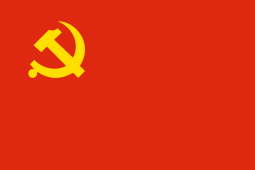 Flag of the Communist Party of China
Flag of the Communist Party of China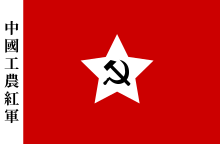
Flag of the Chinese Workers' and Peasants' Red Army 
Flag of the Soviet Union .svg.png) First State Emblem of the Soviet Union (1923-1936)
First State Emblem of the Soviet Union (1923-1936)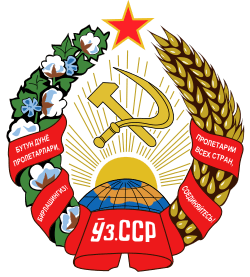 Emblem of the Uzbek Soviet Socialist Republic
Emblem of the Uzbek Soviet Socialist Republic Flag of the Workers' Party of Korea with hammer, sickle, and paintbrush.
Flag of the Workers' Party of Korea with hammer, sickle, and paintbrush..png) State emblem of Lao People's Democratic Republic (1975-1991)
State emblem of Lao People's Democratic Republic (1975-1991)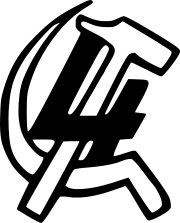
Symbol of the Fourth International  Flag of the Revolutionary People's Liberation Party/Front (Turkey)
Flag of the Revolutionary People's Liberation Party/Front (Turkey)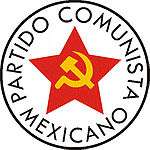
Symbol of the Mexican Communist Party 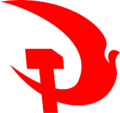
Symbol of the Communist Party of Britain 
The cross and sickle, symbol of Christian communism and Christian socialism
Red star
.svg.png) Flag of People's Republic of Benin (1975-1990)
Flag of People's Republic of Benin (1975-1990)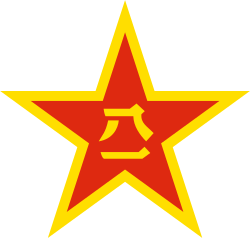 Emblem of the Chinese People's Liberation Army
Emblem of the Chinese People's Liberation Army
Flag of North Korea .svg.png) Coat of arms of Hungarian People's Republic (1957-1990)
Coat of arms of Hungarian People's Republic (1957-1990).svg.png) Emblem of the Transcaucasian SFSR (1930-1936)
Emblem of the Transcaucasian SFSR (1930-1936)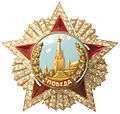 Soviet Order of Victory Award (1945)
Soviet Order of Victory Award (1945) Logo of the United Socialist Party of Venezuela
Logo of the United Socialist Party of Venezuela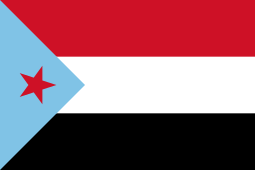 Flag of South Yemen
Flag of South Yemen.svg.png) Coat of Arms of South Yemen (1970-1990)
Coat of Arms of South Yemen (1970-1990).svg.png)
Flag of Socialist Federal Republic of Yugoslavia (1945–1992) 
Emblem of SFR Yugoslavia (1945–1992) 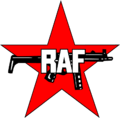 Logo of the Red Army Faction (West Germany)
Logo of the Red Army Faction (West Germany)
Flag of the EZLN and the Neozapatista ideology .svg.png)
Flag of the Popular Front 
Flag of the Kurdistan Workers' Party 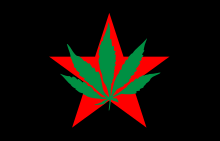
Flag of the Youth International Party
Red and black flag
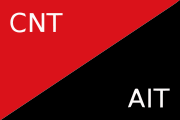
Flag of the Confederación Nacional del Trabajo (Spain) 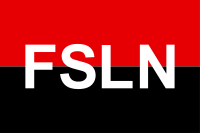
Flag of the Sandinistas (Nicaragua) 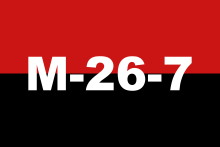
Flag of the 26th of July Movement (Cuba) 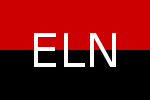
Flag of the National Liberation Army (Colombia) 
Flag of the Rebel Armed Forces (Guatemala) 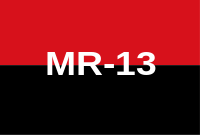
Flag of the Revolutionary Movement 13th November (Guatemala) 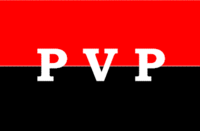
Flag of the Partido por la Victoria del Pueblo (Uruguay) 
Flag of the Revolutionary Left Movement (Chile) .svg.png)
Flag of the People's Movement for the Liberation of Angola .svg.png)
Flag of the Awami Tahreek (Pakistan) 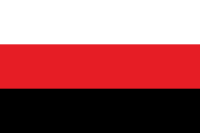
Flag of the Botswana Democratic Party 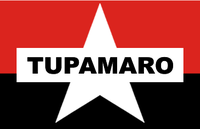
Flag of the Revolutionary Movement Tupamaro (Venezuela) 
Flag of the Intransigent Party (Argentina) 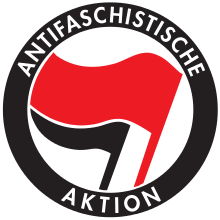 The logo for Antifa
The logo for Antifa The flag of Angola
The flag of Angola
Plough
.svg.png)
The Starry Plough flag used by the Irish Citizen Army 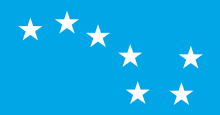
A modern variant of the Starry Plough 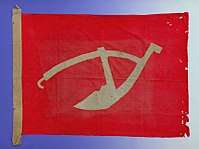
Flag of the Chinese Peasants' Association .png)
Another version of the flag 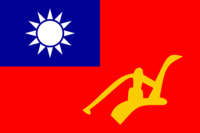
Flag of the Guangdong Peasants' Association during the period of the First United Front
Other symbols

The flag of Vietnam, an example of a red flag with a gold star.  Young Pioneers pin featuring a stylized portrait of Vladimir Lenin
Young Pioneers pin featuring a stylized portrait of Vladimir Lenin Statue of Vladimir Lenin
Statue of Vladimir Lenin Stalin stamp from German Democratic Republic. Stalin's image was commonly used by Marxist–Leninist states and movements
Stalin stamp from German Democratic Republic. Stalin's image was commonly used by Marxist–Leninist states and movements Quotations from Chairman Mao Tse-tung (aka the "Little Red Book), associated with Maoism
Quotations from Chairman Mao Tse-tung (aka the "Little Red Book), associated with Maoism
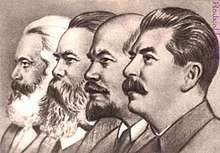 The "Four Heads" of Marxism: Marx, Engels, Lenin, and Stalin
The "Four Heads" of Marxism: Marx, Engels, Lenin, and Stalin
Che Guevara's image, symbol of Guevarism  Worker and Kolkhoz Woman, an example of a statue featuring workers in the style of socialist realism
Worker and Kolkhoz Woman, an example of a statue featuring workers in the style of socialist realism.jpg) A revolutionary worker in socialist realist style
A revolutionary worker in socialist realist style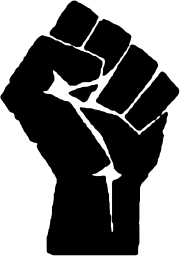 Stylized raised fist, used both as a symbol in itself and as a salute.
Stylized raised fist, used both as a symbol in itself and as a salute. The portraits of Karl Marx, Emiliano Zapata, and Subcomandante Marcos, all symbols used in the Neozapatismo ideology.
The portraits of Karl Marx, Emiliano Zapata, and Subcomandante Marcos, all symbols used in the Neozapatismo ideology.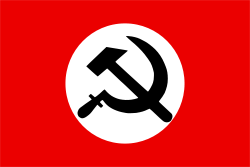 The flag of the National Bolshevik Party, and by extension, National Bolshevism
The flag of the National Bolshevik Party, and by extension, National Bolshevism Badge of the Democratic Army of Greece, with a stylised D (Δ)
Badge of the Democratic Army of Greece, with a stylised D (Δ)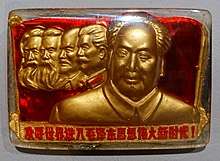 Propaganda pin featuring Karl Marx, Friedrich Engels, Vladimir Lenin, Joseph Stalin & Mao Zedong, People's Republic of China, 1968, molded resin
Propaganda pin featuring Karl Marx, Friedrich Engels, Vladimir Lenin, Joseph Stalin & Mao Zedong, People's Republic of China, 1968, molded resin_(cropped).jpg) Mao Zedong badge from the British Museum
Mao Zedong badge from the British Museum
See also

- Anarchist symbolism
- Fascist symbolism
- Bans on Communist symbols
- Communist chic
- Hammer and sickle (☭)
- The Internationale
- Raised fist
- Red flag (politics) (🚩)
- Red star (★)
- Rose (symbolism)
- Socialist heraldry
- List of socialist songs
- Bans on Communist symbols
- National
- Flag of East Germany
- Flags of the Soviet Republics
- Coat of Arms of the German Democratic Republic
- Coat of Arms of the Socialist Federal Republic of Yugoslavia
- Coats of Arms of the Soviet Republics
- Coats of arms of the Yugoslav Socialist Republics
- National Emblem of the People's Republic of China
- Soviet Union state motto
References
- Hungarian Criminal Code 269 / B. § 1993.
- "Het spook van het communisme waart nog steeds door Europa" (in Dutch). 22 December 2009. Retrieved July 14, 2012.
- 1602 Dekker Satirom. Wks. 1873 I. 233 What, dost summon a parlie, my little Drumsticke? tis too late: thou seest my red flag is hung out. 1666 Lond. Gaz. No. 91/4 That the Red Flag was out, both Fleets in sight of each other, expecting every hour fit weather to Engage. Flags of the World, "Flag of Defiance".
- "Anarchist FAQ Appendix" Archived 2015-09-01 at the Wayback Machine.
- "El socialismo libertario de" (in Spanish). Centro Para la Promoción, Investigación Rural y Social. Archived from the original on 28 September 2007. Retrieved 30 March 2009.
- The Guardian, Australia (25 October 2009). "The International". pp. first paragraph. Archived from the original on 27 October 2009. Retrieved 3 April 2018.
- "002这是好的很 毛泽东发表《湖南农民运动考察报告》发表四十四周年".
- "土地革命时期农民秋收暴动旗帜".
- "彭湃与陆丰农民运动".
- "广明龙农会会旗" Archived 2016-10-25 at the Wayback Machine.
- "#消夏计划#石塘双峰寨——中国的意大利费拉拉式水".
- "【网络媒体走转改】湖北红安这条古街记录过革命时期的壮怀激烈,更见证了新中国的巨大变迁".
- “Che Guevara: Revolutionary & Icon”, by Trisha Ziff, Abrams Image, 2006
- “Communists, Capitalists still buy into Iconic Che Photo, Author says” by Brian Byrnes, CNN, May 5, 2009
Bibliography
- Arvidsson, Stefan (2017). Style and mythology of socialism: socialist idealism, 1871-1914. Routledge.
- Barisone, Silvia, Czech, Hans-Jörg & Doll, Nikola (2007). Kunst und Propaganda im Streit der Nationen 1930 - 1945: eine Ausstellung des Deutschen Historischen Museums Berlin in Zusammenarbeit mit The Wolfsonian-Florida International University. Dresden: Sandstein.
- Groys, Boris (2011 [1992]). The total art of Stalinism: avant-garde, aesthetic dictatorship, and beyond. Verso Books.
- King, David (2009). Red star over Russia: a visual history of the Soviet Union from 1917 to the death of Stalin : posters, photographs and graphics from the David King collection. London: Tate.